Cross-Border Trade and Investment Flows between Asia and the Middle East Set to Expand
H.H. Sheikh Salman bin Khalifa Al Khalifa, Honorary Chairman of the Bahrain Petroleum Company (BAPCO) inaugurates the Asia-Middle East Investment Summit in Singapore
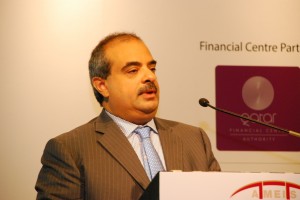
Singapore: 7th June 2012: The inaugural Asia-Middle East Investment Summit (AMEIS 2012), which opened today at the Grand Hyatt Singapore, saw 150 senior decision-makers in the international investment markets engage in critical discussions that focused on expanding the economic linkages and boosting investment ties between Asia and the Middle East. Co-located with the 3rd Annual World Islamic Banking Conference: Asia Summit (WIBC Asia 2012), the event was inaugurated with a special welcome address by H.H. Sheikh Salman bin Khalifa Al Khalifa, Honorary Chairman of the Bahrain Petroleum Company (BAPCO).
Delivering his inaugural address, H.H. Sheikh Salman bin Khalifa Al Khalifa said that “the financial markets in GCC saw increasingly broad, positive, progress in terms of volume trading during the first quarter of 2012, further building on the recovery that began to take shape in the second half of last year. This forward momentum was particularly evident in bank lending and Sukuk markets. These encouraging trends are underpinned to a significant extent by the strong regional economic growth which has benefited from a re-focus in government spending, especially towards infrastructure projects.”
He also said that “throughout the last three decades, Bahrain and Singapore have embraced each other not as competitors but as colleagues, working together with a mutually-shared interest in the development and implementation of international best practices in the field of financial services.”
He also added that “forums such as the Asia-Middle East Investment Summit represent the latest initiative in this recognition of the growing importance of blocs and regions outside of the Eurozone and the USA in providing the engine of growth in the global economy.”
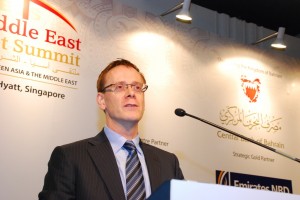
The welcome address was be immediately followed by an opening keynote address by Toby O’Connor, Chief Executive Officer of the Islamic Bank of Asia. A key highlight of AMEIS 2012 was the special keynote address by Ben Simpfendorfer, Managing Director of Silk Road Associates. Ben Simpfendorfer, one the world’s leading experts on relations between Asia and the Middle East and author of the influential “The New Silk Road: How a Rising Arab World is Turning Away from the West and Rediscovering China” shares critical insights on renewing the Silk Road and identifying the growth prospects for Asia-Middle East investment flows.
Ben Simpfendorfer was earlier quote saying that “the global crisis has had little impact on the rise of a new Silk Road, even binding the region together more tightly. Trade between Asia and the Middle East is flourishing, its total value rising above $400 billion last year. The Middle East now supplies 3 out of 10 barrels of oil consumed by China. Korean construction firms earn nearly a third of their total revenues from the Middle East. Even in cross-border investments, change is finally happening, as countries along the new Silk Road look for alternatives to established markets in Europe and the United States. But the key question that remains is where are the new growth sectors and opportunities?”
AMEIS 2012 also featured an exclusive industry leaders’ power debate session that assess the significant growth potential of cross-border trade and investment flows between the Asia and the Middle East as the two regions are set to enter a stronger phase of inter-connectedness. The session, featuring Muzaffar Hisham, Chief Executive Officer of Maybank Islamic Berhad; Shashank Srivastava, Acting Chief Executive Officer and Chief Strategic Development Office of Qatar Financial Centre Authority; and Marc Foss, Executive Director – Middle East of Silk Invest, discussed how investments can be more powerfully mobilized between Asia and the Middle East and how industry leaders can successfully tap into the significant growth potential of cross-border trade and investment flows between the two high-growth regions.
Addressing the media present at the event, David McLean, Chief Executive of the Asia-Middle East Investment Summit, said that “Asia and the Middle East are two regions of the world that not only have immense potential in themselves but also have the potential to shape each other’s futures for the better. With Asia and the Middle East being on an upward trajectory of economic growth, the increasing trade and financial flows between the two regions are in many ways obvious. With both the regions aiming for a more diversified and balanced growth, and given abundance of liquidity and capital in both the regions, there are significant opportunities for cross-border trade and investment flows as investors look for markets which can offer higher returns at acceptable risk levels.”
A similar view was expressed by Giel Jan M. Van Der Tol, Group Head of Wholesale Banking at Emirates NBD, who said that “with the economic centre of the world rapidly shifting towards the East, it’s more important than ever for there to be greater connectivity between the Middle East and the fast growing economies in Asia, beyond the traditional role of the Middle East as a provider of energy resources. With the trade and financial ties between the Middle East and Asia strengthening by the day, new avenues for significant cross-border investments are opening up which need to be effectively translated into meaningful transactions.”
“As the Gold Strategic Partner of the Asia-Middle East Investment Summit (AMEIS 2012), we are pleased to play a key role in boosting deeper relations between these two dynamic high growth regions”, he added.
 Cash And Trade Magazine For Cash and Trade professionals in the Middle East
Cash And Trade Magazine For Cash and Trade professionals in the Middle East

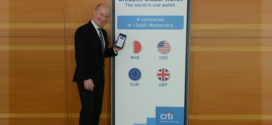
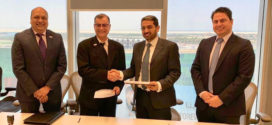
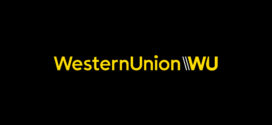
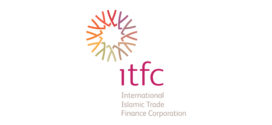
One comment